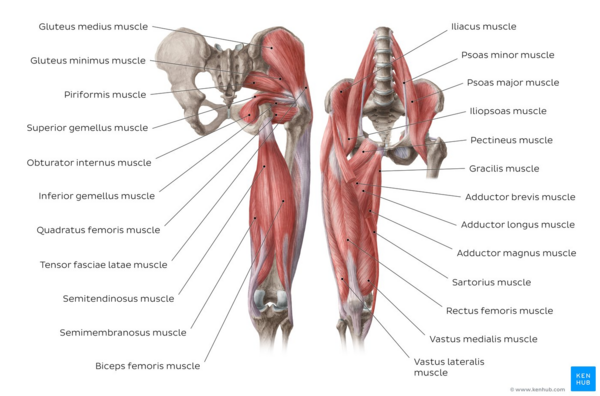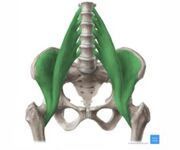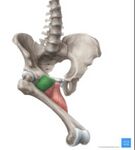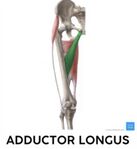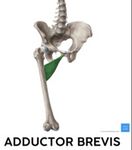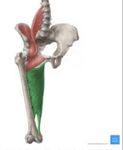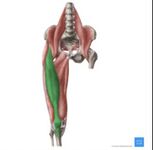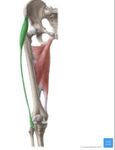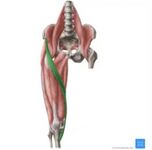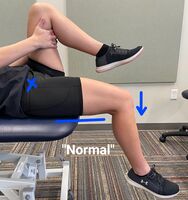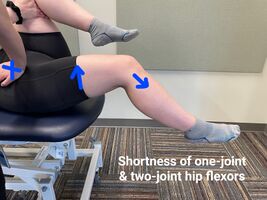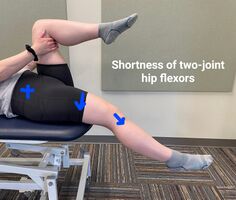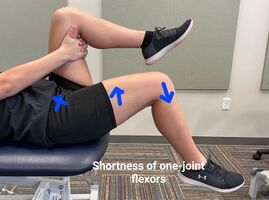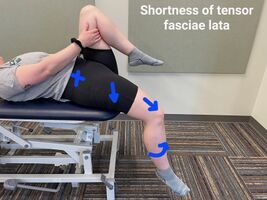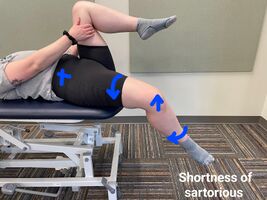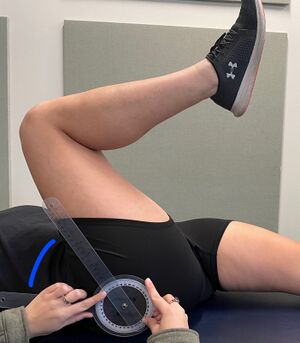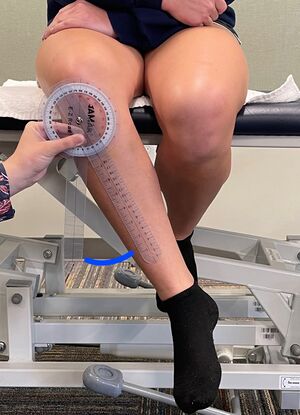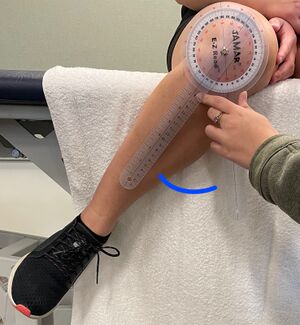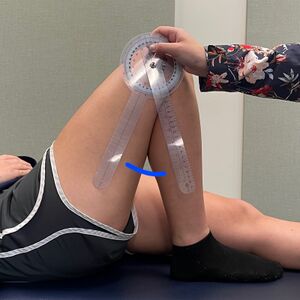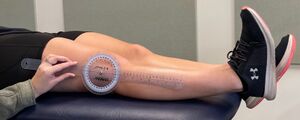Thomas Test: Difference between revisions
No edit summary |
(I added images to the interpretation table and the ROM table.) |
||
| Line 19: | Line 19: | ||
There are various muscles making up the hip flexor group being tested in the Thomas Test: | There are various muscles making up the hip flexor group being tested in the Thomas Test: | ||
{| class="wikitable" | {| class="wikitable" | ||
|Hip Flexor Muscle | |'''Hip Flexor Muscle''' | ||
|Picture | |'''Picture''' | ||
(Muscle in green) | '''(Muscle in green)''' | ||
|Number of Joints Crossed | |'''Number of Joints Crossed''' | ||
|Main Function | |'''Main Function''' | ||
|Additional Movement | |'''Additional Movement''' | ||
|- | |- | ||
|Iliopsoas: Composed of iliacus and psoas major | |Iliopsoas: Composed of iliacus and psoas major | ||
| Line 104: | Line 104: | ||
The table below describes various presentations of a positive Thomas test and the muscles affected. | The table below describes various presentations of a positive Thomas test and the muscles affected. | ||
{| class="wikitable" | {| class="wikitable" | ||
|Presentation | |'''Presentation''' | ||
|Muscle(s) Affected | |'''Muscle(s) Affected''' | ||
|Signs | |'''Signs''' | ||
|- | |- | ||
|Typical length of hip flexors. (negative test) | |Typical length of hip flexors. (negative test)[[File:Normal length of hip flexors.jpg|center|thumb|200x200px]] | ||
|Psoas major and iliacus, rectus femoris, tensor fasciae latae, sartorius, pectineus, adductor longus/brevis/magnus | |Psoas major and iliacus, rectus femoris, tensor fasciae latae, sartorius, pectineus, adductor longus/brevis/magnus | ||
|Posterior thigh touches the table, knee flexes ~ 80° | |Posterior thigh touches the table, knee flexes ~ 80° | ||
|- | |- | ||
|Shortness of both one-joint and two-joint hip flexors. (positive test) | |Shortness of both one-joint and two-joint hip flexors. (positive test)[[File:Shortness of one & two-joint muscles.jpg|center|thumb|267x267px]] | ||
|Psoas major and iliacus, rectus femoris, tensor fasciae latae, sartorius, pectineus, adductor longus/brevis/magnus | |Psoas major and iliacus, rectus femoris, tensor fasciae latae, sartorius, pectineus, adductor longus/brevis/magnus | ||
|Posterior thigh does not touch the table, the knee extends. | |Posterior thigh does not touch the table, the knee extends. | ||
|- | |- | ||
|Shortness of two-joint hip flexors. (positive test) | |Shortness of two-joint hip flexors. (positive test)[[File:Two-joint hip flexor tightness.jpg|center|thumb|236x236px]] | ||
|Rectus femoris, tensor fasciae latae, sartorius | |Rectus femoris, tensor fasciae latae, sartorius | ||
|Posterior thigh touches the table, knee extends | |Posterior thigh touches the table, knee extends | ||
|- | |- | ||
|Shortness of one-joint hip flexors. (positive test) | |Shortness of one-joint hip flexors. (positive test)[[File:One-joint hip flexor tightness.jpg|center|thumb|269x269px]] | ||
|Iliopsoas, pectineus, adductor longus/brevis/magnus | |Iliopsoas, pectineus, adductor longus/brevis/magnus | ||
|Posterior thigh does not touch table, knee flexes >80° | |Posterior thigh does not touch table, knee flexes >80° | ||
|- | |- | ||
|Shortness of tensor fasciae latae. (positive test) | |Shortness of tensor fasciae latae. (positive test)[[File:Tightness of tensor fasciae latae.jpg|center|thumb|267x267px]] | ||
|Tensor fasciae latae | |Tensor fasciae latae | ||
|Abduction of the thigh as hip joint extends, lateral deviation of the patella. Knee extension if abduction/adduction is prevented with hip extension. Internal rotation of the thigh and external rotation of the leg on the femur. | |Abduction of the thigh as hip joint extends, lateral deviation of the patella. Knee extension if abduction/adduction is prevented with hip extension. Internal rotation of the thigh and external rotation of the leg on the femur. | ||
|- | |- | ||
|Shortness of sartorius. (positive test) | |Shortness of sartorius. (positive test)[[File:Tightness of Sartorius.jpg|center|thumb|267x267px]] | ||
|Sartorius | |Sartorius | ||
|Abduction, flexion, external rotation of the hip and flexion of the knee. Combination of three or more indicates tightness. | |Abduction, flexion, external rotation of the hip and flexion of the knee. Combination of three or more indicates tightness. | ||
| Line 146: | Line 146: | ||
<nowiki>*</nowiki>A- axis, SA- stationary arm, MA- movement arm | <nowiki>*</nowiki>A- axis, SA- stationary arm, MA- movement arm | ||
{| class="wikitable" | {| class="wikitable" | ||
|Action | |'''Action''' | ||
|Typical Degrees of Motion | |'''Typical Degrees of Motion''' | ||
|Technique<ref name=":1" /> | |'''Technique'''<ref name=":1" /> | ||
|Picture | |'''Picture''' | ||
|- | |- | ||
|Hip Flexion | |Hip Flexion | ||
| Line 160: | Line 160: | ||
MA: Aligned with femur (lateral epicondyle) | MA: Aligned with femur (lateral epicondyle) | ||
| | |[[File:Hip Flexion ROM.jpg|thumb]] | ||
|- | |- | ||
|Hip Extension | |Hip Extension | ||
| Line 171: | Line 171: | ||
MA: Aligned with femur (lateral epicondyle) | MA: Aligned with femur (lateral epicondyle) | ||
| | |[[File:Hip Extension ROM.jpg|thumb]] | ||
|- | |- | ||
|Hip Internal Rotation | |Hip Internal Rotation | ||
| Line 182: | Line 182: | ||
MA: Aligned with leg (crest of tibia) | MA: Aligned with leg (crest of tibia) | ||
| | |[[File:Hip Internal Rotation ROM.jpg|thumb]] | ||
|- | |- | ||
|Hip External Rotation | |Hip External Rotation | ||
| Line 191: | Line 191: | ||
SA: Aligned vertically MA: Aligned with leg (crest of tibia) | SA: Aligned vertically MA: Aligned with leg (crest of tibia) | ||
| | |[[File:Hip External Rotation ROM.jpg|thumb]] | ||
|- | |- | ||
|Knee flexion | |Knee flexion | ||
| Line 202: | Line 202: | ||
MA: Lateral malleolus | MA: Lateral malleolus | ||
| | |[[File:Knee Flexion ROM.jpg|thumb]] | ||
|- | |- | ||
|Knee extension | |Knee extension | ||
| Line 213: | Line 213: | ||
MA: Lateral malleolus | MA: Lateral malleolus | ||
| | |[[File:Knee Extension ROM.jpg|thumb]] | ||
|} | |} | ||
Revision as of 01:00, 6 April 2023
<div class="noeditbox">Welcome to [[Arkansas Colleges of Health Education School of Physical Therapy Musculoskeletal 1 Project]]. This space was created by and for the students at Arkansas Colleges of Health Education School in the United States. Please do not edit unless you are involved in this project, but please come back in the near future to check out new information!!</div>
Original Editor - Tyler Shultz
Top Contributors - Aurelie Canas Perez, Maddison Jones, Admin, Ashtyn Madden, Kim Jackson, Magdalena Hytros, Rachael Lowe, Lucinda hampton, Shelby Morrison, Joao Costa, Tyler Shultz, Johnathan Fahrner, Yvonne Yap, Kevin Campion, Leana Louw, Sue Safadi, Tony Varela, Matt Huey, Kai A. Sigel, Wanda van Niekerk, Oyemi Sillo, Naomi O'Reilly and Adam Vallely Farrell
<div class="noeditbox">Welcome to [[Arkansas Colleges of Health Education School of Physical Therapy Musculoskeletal 1 Project]]. This space was created by and for the students at Arkansas Colleges of Health Education School in the United States. Please do not edit unless you are involved in this project, but please come back in the near future to check out new information!!</div>
Purpose[edit | edit source]
The Thomas Test measures hip flexor length and distinguishes tightness between one joint and two joint muscles.[1]
- Impaired range of motion of the hip may be an underlying cause to other conditions such as: psoas syndrome; patellofemoral pain syndrome; lower back pain, osteoarthritis; rheumatoid arthritis.
- Often associated with runners, dancers, and gymnasts who complain of hip "stiffness" and reported "snapping" feeling when flexing at the waist.
Image: Overview of the hip and thigh - anterior and posterior views[2]
Relevant Anatomy[edit | edit source]
There are various muscles making up the hip flexor group being tested in the Thomas Test:
| Hip Flexor Muscle | Picture
(Muscle in green) |
Number of Joints Crossed | Main Function | Additional Movement |
| Iliopsoas: Composed of iliacus and psoas major | One joint: Hip | Hip flexion | Hip external rotation | |
| Pectineus | One joint: hip | Hip flexion | Hip abduction | |
| Adductor Longus & Brevis | One joint: hip | Hip adduction | Hip flexion and external rotation | |
| Adductor Magnus | One joint: hip | Adductor part: Hip flexion, adduction, external rotation | Hamstring part: Hip extension and internal rotation. | |
| Rectus femoris | Two joints: Hip and knee | Hip flexion | Knee extension | |
| Tensor fascia lata | Two joints: Hip and knee | Hip abduction, flexion, internal rotation | Knee extension | |
| Sartorius | Two joints: Hip and knee | Hip flexion, abduction, external rotation | Knee flexion |
"The copyright holder has given special permission to use these images in Physiopedia"
This 16 minute video is a good summary of the lower extremity muscles.
How to Remember Every Muscle of the Lower Limb and Leg | Corporis[1]
Equipment[edit | edit source]
- Stable/firm table.
- Goniometer.
- Chart for recording findings.[1]
Technique[edit | edit source]
Starting Position: Patient is seated at the end of a table with half of their thigh off the edge. Examiner places one hand behind the patient’s knee and another behind their back before helping them to lay back onto the table with their knee flexed.[1] Patient keeps the unaffected leg flexed, and slowly lowers the affected leg and lets it extend as far as it can. Avoid bringing both knees into flexion as it allows for excessive posterior tilt of the pelvis.
Correct Testing:
- Examiner helps to lay patient back onto the table
- Low back and sacrum are flat on the table
- Flexed leg is in 90 degrees of hip flexion (perpendicular to the table)
- Helps to improve accuracy across across tests/retests
Errors in Testing:
- Patient lays back on their own- unless doing the modified test
- Patient pulls leg into too much flexion- pulling thigh off table
- Low back and sacrum are not flat on the table[1]
Modified Version- Patient positioned in sitting at the end of an examination table. Patient is then asked to lie down while bringing both knees to their chest. They should then perform a posterior pelvic tilt- flat back. One limb should then be lowered towards the table while keeping the opposite tucked towards their chest[3].
Interpretation[edit | edit source]
The table below describes various presentations of a positive Thomas test and the muscles affected.
| Presentation | Muscle(s) Affected | Signs |
| Typical length of hip flexors. (negative test) | Psoas major and iliacus, rectus femoris, tensor fasciae latae, sartorius, pectineus, adductor longus/brevis/magnus | Posterior thigh touches the table, knee flexes ~ 80° |
| Shortness of both one-joint and two-joint hip flexors. (positive test) | Psoas major and iliacus, rectus femoris, tensor fasciae latae, sartorius, pectineus, adductor longus/brevis/magnus | Posterior thigh does not touch the table, the knee extends. |
| Shortness of two-joint hip flexors. (positive test) | Rectus femoris, tensor fasciae latae, sartorius | Posterior thigh touches the table, knee extends |
| Shortness of one-joint hip flexors. (positive test) | Iliopsoas, pectineus, adductor longus/brevis/magnus | Posterior thigh does not touch table, knee flexes >80° |
| Shortness of tensor fasciae latae. (positive test) | Tensor fasciae latae | Abduction of the thigh as hip joint extends, lateral deviation of the patella. Knee extension if abduction/adduction is prevented with hip extension. Internal rotation of the thigh and external rotation of the leg on the femur. |
| Shortness of sartorius. (positive test) | Sartorius | Abduction, flexion, external rotation of the hip and flexion of the knee. Combination of three or more indicates tightness. |
A muscle's strength and available length directly correlate to the range of motion at a joint. Two principles exist that describe the relationship between muscle strength and length and joint range of motion:
Active insufficiency: Occurs when a two joint muscle, produces movement at both joints simultaneously, and reaches a shortened length at which it can no longer generate force.[4] [Kendall et al.] Active insufficiency refers to a lack of muscle strength.[1]
Passive insufficiency: Occurs when a two-joint muscle is in such a lengthened position that it cannot sufficiently permit motion at both joints.[4] [Kendall et al.] Passive insufficiency refers to a lack of muscle length, the muscle is tight.[1]
Active and passive insufficiency principles describe potential reasons for decreased range of motion at a joint.
Goniometer: Goniometer measurements can also assist the clinician in determining the available range of motion at a joint. Goniometer measurements are unique to each individual person, therefore they should be compared bilaterally.
The following are considered to be typical goniometer measurements for the hip and knee:
*A- axis, SA- stationary arm, MA- movement arm
| Action | Typical Degrees of Motion | Technique[1] | Picture |
| Hip Flexion | 125°[1] | Supine with knee flexed
A: Greater trochanter SA: Aligned with midline of pelvis MA: Aligned with femur (lateral epicondyle) |
|
| Hip Extension | 10°[1] | Prone with pelvis stabilized
A: Greater trochanter SA: Aligned with midline of pelvis MA: Aligned with femur (lateral epicondyle) |
|
| Hip Internal Rotation | 32°[5] | Seated on table with knee flexed
A: Center of patella SA: Aligned vertically MA: Aligned with leg (crest of tibia) |
|
| Hip External Rotation | 32°[5] | Seated on table with knee flexed
A: Center of patella SA: Aligned vertically MA: Aligned with leg (crest of tibia) |
|
| Knee flexion | 140°[1] | Supine
A: Lateral epicondyle SA: Greater trochanter MA: Lateral malleolus |
|
| Knee extension | 0°[1] | Supine with prop under heel
A: Lateral epicondyle SA: Greater trochanter MA: Lateral malleolus |
Viewing[edit | edit source]
Contraindications[edit | edit source]
Contraindications describe conditions, that if present, the Thomas test should not be performed. Contraindications are a clinical reasoning responsibility of the evaluating physical therapist.
- Posterior hip replacement
- Suspected fracture- lower extremity, hip, sacrum
Relative Contraindications
- Acute lumbar instability
- Suspected muscle injury- hip flexors
Reliability[edit | edit source]
Studies that test the reliability of the Thomas study are very limited.
- One study has demonstrated that the modified Thomas test has a very good inter-rater reliability.[6] Another has demonstrated that the modified Thomas test, has an average of only moderate levels of reliability.[7] Further research is required to prove or to refute the reliability of the Thomas test.
- Peeler & Anderson conducted a study in 2006 examining the reliability of the Thomas test for assessing hip range. Their study calls into question the reliability of the technique when used to score range of motion and iliopsoas muscle flexibility about the hip joint using both goniometer and pass/fail scoring methods.[8]
- Boone et al revealed higher intertester reliability for upper-extremity measurements than for lower extremity measurements, meaning different examiners are more consistent in measuring upper-extremity than lower extremity range of motion.[9][5] However, other studies have demonstrated very high intra-rater reliability, meaning the same examiner can consistently obtain the same ROM values.[10]
References[edit | edit source]
- ↑ 1.00 1.01 1.02 1.03 1.04 1.05 1.06 1.07 1.08 1.09 1.10 1.11 Kendall F, McCreary E, Provance P. Muscles: Testing and Function with Posture and Pain. 4th ed. Baltimore: Lippincott, Williams & Wilkins; 1993.
- ↑ Overview of the hip and thigh - anterior and posterior views image - © Kenhub https://www.kenhub.com/en/library/anatomy/hip-and-thigh-anatomy
- ↑ Dutton M. Dutton’s orthopedic survival guide managing common conditions /. New York, N.Y.: Mcgraw-Hill Education Llc., C; 2011.
- ↑ 4.0 4.1 O’Connell A, Gardner E. Understanding the Scientific Basis of Human Motion. Baltimore: Williams & Wilkins; 1972.
- ↑ 5.0 5.1 5.2 Roach KE, Miles TP. Normal Hip and Knee Active Range of Motion: The Relationship to Age. Physical Therapy [Internet]. 1991 Sep 1 [cited 2019 Mar 24];71(9):656–65. Available from: https://pdfs.semanticscholar.org/7e60/2a134667ff5f6f5dda8c7608a59f204d662c.pdf
- ↑ Gabbe BJ, Bennell KL, Wajswelner H, Finch CF. Reliability of common lower extremity musculoskeletal screening tests. Physical Therapy in Sport 2004;5(2):90-7.
- ↑ Clapis PA, Davis SM, Davis RO. Reliability of inclinometer and goniometric measurements of hip extension flexibility using the modified Thomas test. Physiotherapy theory and practice 2008;24(2):135-41.
- ↑ Peeler J, Anderson JE. Reliability of the Thomas test for assessing range of motion about the hip. Physical Therapy in Sport. 2007;8(1):14-21.
- ↑ Boone DC, Azen SP, Lin CM, Spence C, Baron C, Lee L. Reliability of Goniometric Measurements. Physical Therapy. 1978 Nov 1;58(11):1355–60.
- ↑ Watkins MA, Riddle DL, Lamb RL, Personius WJ. Reliability of Goniometric Measurements and Visual Estimates of Knee Range of Motion Obtained in a Clinical Setting. Physical Therapy. 1991 Feb 1;71(2):90–6.
